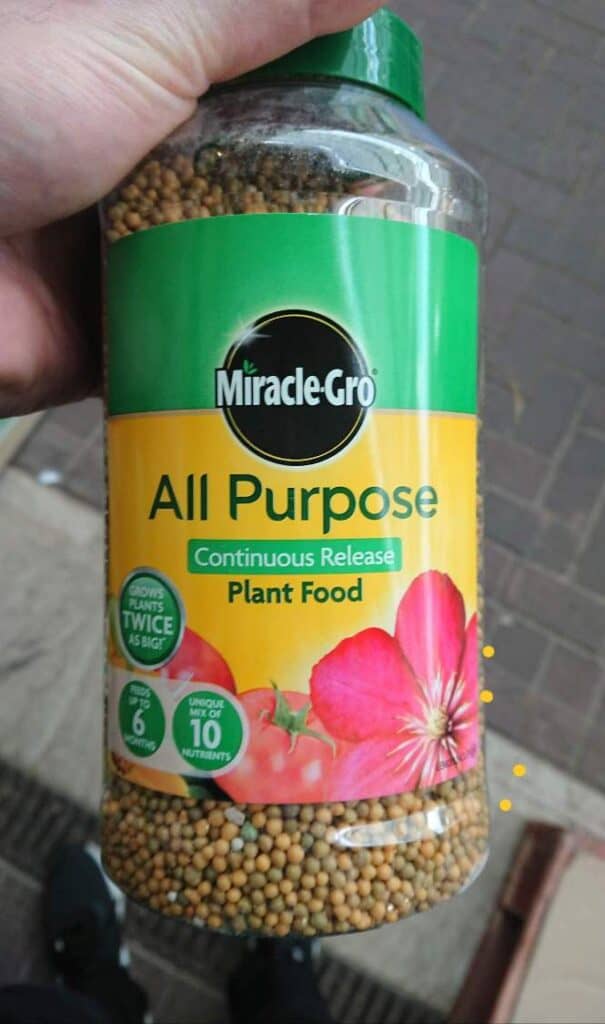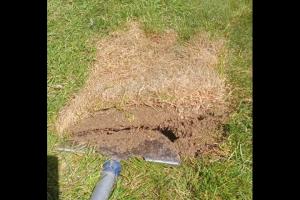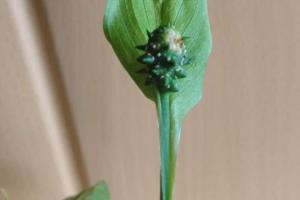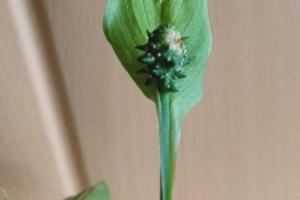How to Revive Dying Lilies
The reason for lilies dying is usually because the bulbs are overcrowded or planted to shallow. Lilies bulbs should be planted 8 inches apart and 6-8 inches deep. If the bulbs are too shallow or too close together the lily leaves turn yellow then brown and die back.
If your lilies have not come up after Winter then they have either rotted in soil that is too damp or they are planted too shallow and have frozen over Winter. The bulbs are sensitive to cold temperature and must be planted a sufficient depth to be insulated from the cold Winter temperatures and frost.
The Asiatic lilies and their hybrids are by far the most cold hardy variety of lily.
Here is a table summarizing the most common reasons for dying lilies…
| Symptoms of Dying Lilies: | Causes for Lilies Dying Back: |
| Leaves turn Yellow: | Individual leaves turn yellow and die back during the year naturally. Overwatering, underwatering, a nutrient deficit in the soil, overcrowding of the bulbs and frost damage can all cause yellowing leaves. |
| Lily Drooping, Wilting and Dying back: | Drooping is most often due to a combination of high temperatures, hydrophobic soil, blazing sunshine, sandy soils that drain too quickly. Too much nitrogen in the soil can also cause lilies to droop. |
| Leaves turn Brown: | Scorched leaves from intense sunshine turn the leaves brown. The bulbs may also be planted too shallow or crowded too close together. Drought stress, physical damage to the leaves and frost can cause brown leaves. |
It is important to acknowledge that whilst lilies are perennials, the foliage above the ground turn yellow/brown and dies back in the Fall/Winter. The bulbs stays alive below ground and the lilies regrow in the Spring.
Lily Leaves Turning Yellow (Lily Leaves Turn Yellow as they Age)
- Symptoms: Yellowing leaves that can also turn brown, droop and die back.
- Causes: Aging leaves, overwatering, underwatering, lack of nutrients, overcrowded bulbs, sudden drop in temperature.
The older leaves on your lilies typically turn yellow through the season as new growth develops. So if it is just one or two of the older leaves of your lilies are turning yellow then your lilies are not dying, this is just a natural part of the lilies life cycle.
Once the leaves have turned yellow and withered you can trim these individual dying leaves back with a sharp pair of pruners.
Sometimes lily leaves turn yellow if the bulbs are planted too close together. Ideally lily bulbs should be planted 8 inches apart so that each individual bulb has enough access to moisture and nutrients.
When each bulb is competing for nutrients to fuel their Spring growth spurt they can often exhaust the soil immediately around them of nutrients which causes the leaves to turn yellow (often due to a deficit of nitrogen).
Overwatering or saturated soils can also exclude oxygen from the soil which prevents the lilies roots from respiring.
If the roots cannot respire then they cannot uptake the moisture and nutrients that the lilies leaves need to stay green resulting in yellowing drooping growth that dies back.
Equally underwatering, drought or soils that do not retain enough moisture can turn the leaves yellow with severe drought stress turning the lily’s leaves brown with a drooping appearance.
Anecdotally I have noticed that not enough sun can turn the leaves yellow and droop often turning brown and dying back.
Cold snaps from a late frost are also often responsible for a yellowing or browning of the lily leaves. Once the cold damage has happened there is not much you can do other then wait until you see signs of regrowth and the cut back any damaged foliage.
It is worth re emphasizing that lily leaves turn yellow and brown and die back every Fall and Winter before regrowing the following Spring. This is a natural cycle and nothing to be concerned about.
How to Revive Lilies with Yellowing, Dying Leaves
The key to saving the lilies with yellow leaves is to identify the cause and create a more favourable conditions for the lilies to grow.
- Measure how far apart the bulbs are, and if they are closer then 8 inches dig them up and plant them further apart. You may not able to revive the lilies this year but if you dig the bulbs up in the Fall (this is the best time for replanting lilies bulbs) and replant them 8 inches apart then they are going to have enough room to access the resources they need to keep the leaves green and display flowers.
- If your lilies are in less then 6 hours of direct sunlight, then relocate your bulbs, ensuring that they are planted in and area of the garden that has at least 6 hours of sun, with morning sunlight being optimal for growth and flowering. You can also cut back any overhanging tree bows or nearby foliage that may be casting light on the lilies.
- Plant the bulbs in well draining, moisture retentive soil to alleviate any problems associated with under or over watering. In practice, this means planting the bulbs in soil that has been amended with lots of compost as compost retains the moisture the lily bulbs require whilst also being porous enough to allow excess water to drain away preventing problems with moisture stress which can both turn the leaves yellow. If your bulbs are in dry soil then the problem is more easily addressed, however if they are in boggy soil, I recommend to either stop water them or ideally dig them up and repot them in order to prevent the bulbs from rotting.
- I recommend using an all purpose granular fertilizer on your lilies when they start to show signs of growth once a month in the Spring. As Spring growth requires a lot of nutrients from the soil, using a fertilizer can prevent the leaves from turning yellow and also promote flowers. I personally use miracle gro fertilizer on my lilies as it contains all the nutrients the lilies require at the right concentration. Whilst some of the yellow leaves do not turn green again, fertilizer provides the lily with the energy to grow new green leaves, giving the bulbs the best prospects for flowering.

- Keep feeding the lilies even after they have flowered. The foliage of outdoor lilies dies back in Winter but you should carry on feeding the lilies whilst the leaves are still green as this is the time the lily is putting energy back into the bulb for next years display of flowering. If you keep feeding after flowering the lilies can uptake the nutrients to store in the bulb which should give it more energy for next years growth and decrease the risk of the leaves turning yellow. Stop feeding once the leaves have died back due to Winter and cut back the dying foliage.
Once you have addressed the environmental stress that caused the yellowing leaves the lilies should be able to recover.
However once the lily’s leaves have turned yellow they do not typically turn green again. Eventually the yellow leaves die back, however new leaves and flowers should emerge if the conditions are favourable.
(Read my article, why are my lilies not flowering?)
Lily Leaves Wilting, Drooping and Falling Over (Drought Stress)
- Symptoms: Lily leaves, stems and flowers droop over.
- Causes: Drought stress and excess heat. Overwatering and too much fertilizer are also common causes.
The most common reason for drooping lilies is because of drought stress due to excess heat and dry soil.
Lilies need evenly moist soil to prevent the leaves and flowers wilting.
However, the lily’s leaves and foliage often droop and wilt as a temporary response to excessively high temperatures.
In the the Summer with blazing sun and high temperatures the leaves droop to reduce the surface size of the leaves which reduces transpiration (water loss) from the leaves.
This is a survival strategy to cope with unfavourably high temperatures and potential drought stress and the lilies often start to revive when the temperatures cool.
Lilies can wilt due to drought stress due to:
- A lack of rainfall or watering.
- The soil is sandy or stoney and does not retain enough moisture.
- If the lilies are near other shrubs or trees then their roots can dry out the soil as they draw up moisture.
- The surface of the soil can bake hard in Summer and become hydrophobic (repel water) which causes water to trickle off the surface of the soil without infiltrating properly and reaching the roots.
It is possible that the lilies could wilt due too overwatering or boggy soils as this prevents the roots from respiring, so ensure the soil is moist but not saturated.
I have personally seen an example of lilies drooping due to excess fertilizer which was actually lawn fertilizer that had dissolved in heavy rain and ran off into the boarder with the lilies causing them to droop due to excess nitrogen.
This can also happen if you apply regular fertilizer too often or in too high concentration.
How to Revive Wilting, Drooping Lilies That are Falling Over
- Give the soil a generous soak with a hose pipe to ensure it is evenly moist. It can take a lot of water to ensure that the soil is evenly moist, particularly if the soil has been exposed and baked in the sun to the point its hard, cracked and repelling water off the surface.
- Once you have soaked the ground apply a one inch layer of mulch to the surface of the soil around the base of the lilies to lock in the moisture. The best mulches for retaining moisture are compost, leaf mould and well rotted manure. These three materials also add nutrients to the soil and create the optimal soil structure for lilies. Mulch also prevents the surface of the soil from baking hard in blazing sun and high temperatures.
- If the soil is dry due to other trees and shrubs up taking moisture from the soil or the soil is sandy and drains too quickly then I recommend transplanting your bulbs in the Fall and replanting them in soil (preferably away from large trees, hedgerows or shrubs) that has been amended with compost to create the best soil conditions for the lilies to thrive.
- If the soil is boggy (which can be the case with heavy clay or low lying areas) then dig up the bulbs replant your lilies in pots, raised beds or better draining areas of the garden that are amended with compost.
You can also just ensure that the lilies are well watered, apply mulch and fertilizer to compensate for any roots of other plants that can draw up resources away from your lilies if you do not want to move them.
I have personally found this approach works well with lilies and other flowering bulbs.
Sometimes it may be the case that you may just have to wait for a heat wave to cool or sometimes the lilies acclimate to the hotter weather and stand back up again after drooping.
Watering and apply mulch to keep the bulbs cool helps in this scenario.
Lily Leaves Turning Brown and Dying
- Symptoms: Brown, wilting leaves that die back. The leaves may also turn from yellow to brown and die back.
- Causes: Too much direct sunlight, shallow planting or planting too close together, physical trauma to the leaf, drought stress and sudden drop in temperature.
The most common reason for lilies turning brown is that they are in too much direct sunlight. Lilies require 6 hours of direct sunlight but prefer morning sun as the temperatures are cooler and it is less intense then afternoon sun which can scorch the leaves brown.
It depends on climate and location but if you are in a hot country and have blazing sunshine then scorched leaves due to sun exposure is the most likely reason for brown leaves.
However, in my experience the lily leaves can turn brown if the bulbs are planted too shallow then they may dry out too quickly.
Lily bulbs should be planted 4 times deeper then the size of the bulb, so if the bulb is 2 inches it should be planted 8 inches deep which allows it to access the moisture and nutrients it needs and protects it from cold in the Winter.
I have also seen lily leaves turn yellow and brown when the bulbs are overcrowded as they all have to compete for moisture and nutrients with one another, hence the importance of planting the bulbs as much as 8 inches apart to prevent the leaves dying and to promote flowering.
Physical trauma to the leaves can also turn them brown if the lily leaves have been damaged in some way perhaps by a pet or grazed by deer etc.
Brown, dying leaves can also indicate severe drought which may be from lack of rainfall, sandy soil, heat and sun etc. the leaves typically turn yellow in response to drought before turning brown and dying back in severe drought.
A sudden drop in temperature and a frost can also turn the lily leaves brown.
Keep in mind that all lily leaves turn yellow and brown when the foliage above ground dies back before Winter. This is a natural part of the lilies life cycle and the bulbs should produce new growth in the following Spring.
How to Revive a Lily with Brown Dying Leaves
Once the lily’s leaves have turned brown they do not turn green again, so it is a case of adjusting the lily’s environment to create more favourable conditions to revive the plant.
- If your in a hot climate with blazing sunshine and your lilies are in the afternoon sun then it is necessary to move your bulbs to a location with 6 hours of morning sun with shade in the afternoon. You can also provide shade in the afternoon with tactical planting of other shrubs or even potted plants moved to cast shade to alleviate the stress on the lily bulbs.
- If you think you have planted the bulbs too near the soils surface then the best course of action is to keep the soil well watered and wait until the Fall when the lilies are dormant and replant them to a depth that is 4 times deeper then the bulb itself (6-8 inches). You can attempt to replant the bulbs during the growing season if they are particularly shallow and all the growth is dying back.
- If the bulbs are overcrowded then replant each bulb 8 inches apart so that each individual lily has enough soil to draw up nutrients and moisture.
- To mitigate the drought stress that causes brown leaves it is important to throughly water the soil and apply a 1 inch layer of compost mulch to retain moisture. Regular application of mulch help to improve the soils capacity to hold moisture which prevents further drought stress and improves the conditions for the lilies.
- If the lily leaves have turned brown due to a cold snap or the leaves have been physically damaged by grazing animals then these leaves do not recover. For cold weather you can provide protection with horticultural fleece if there is another cold snap forecast.
In all scenarios I would wait until the lily grows some more green leaves when conditions improve. As soon as the lily has new growth you can trim back any brown, dying leaves.
Key Takeaways:
- Dying lilies are often because the bulbs are planted too shallow or too close together. Bulbs should be planted 8 inches deep to protect from frost and 8 inches apart so they don’t compete with each other for moisture and nutrients. Shallow planting causes leaves to turn yellow, then brown and die back.
- To revive dying lilies create their optimal conditions by planting the bulbs 8 inches deep and 8 inches apart in 6 hours of morning sun and ensure that the bulbs are planted in moisture retentive, well draining soil. Cut back any brown or yellow leaves to stimulate new growth.









